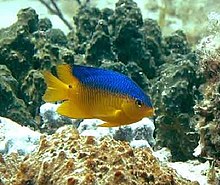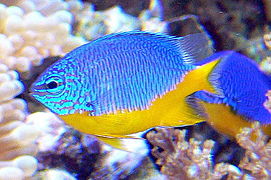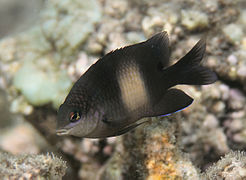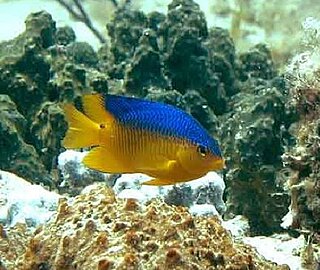
Damselfish are those within the subfamilies Abudefdufinae, Chrominae, Lepidozyginae, Pomacentrinae, and Stegastinae within the family Pomacentridae. Most species within this group are relatively small, with the largest species being about 30cm in length. Most damselfish species exist only in marine environments, but a few inhabit brackish or fresh water. These fish are found globally in tropical, subtropical, and temperate waters.
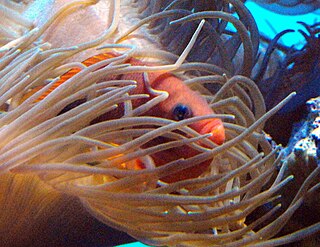
Amphiprion is a genus of ray-finned fish which comprises all but one of the species of clownfish or anemonefish in the subfamily Amphiprioninae of the family Pomacentridae.
A yellowtail may be any of several different species of fish. Most commonly the yellowtail amberjack Seriola lalandi is meant. In the context of sushi, yellowtail usually refers to the Japanese amberjack, Seriola quinqueradiata. Other species called simply "yellowtail" include:

Premnas biaculeatus, commonly known as spine-cheeked anemonefish or the maroon clownfish, is a species of anemonefish found in the Indo-Pacific from western Indonesia to Taiwan and the Great Barrier Reef. They can grow up to be about 17 cm (6.7 in). Like all anemonefishes it forms a symbiotic mutualism with sea anemones and is unaffected by the stinging tentacles of the host anemone. It is a sequential hermaphrodite with a strict size-based dominance hierarchy; the female is largest, the breeding male is second largest, and the male nonbreeders get progressively smaller as the hierarchy descends. They exhibit protandry, meaning the breeding male changes to female if the sole breeding female dies, with the largest nonbreeder becoming the breeding male. The fish's natural diet includes algae and zooplankton.

Abudefduf, also known as the sergeant-majors, is a genus of fish in the family Pomacentridae.

Amblyglyphidodon is a genus of fish in the family Pomacentridae. These damselfish swim singly, in pairs, or in small groups. They are often found among corals.

Chrysiptera is a genus of damselfish in the family Pomacentridae.

Stegastes nigricans, the dusky farmerfish, is a species of damselfish found around coral reefs at a depth of one to 12 meters, in tropical climates between 30°S and 30°N. They are known for farming monocultures of algae such as cyanophores and rhodophytes.

The nosestripe clownfish or nosestripe anemonefish, skunk clownfish, Amphiprion akallopisos, is an anemonefish that lives in association with sea anemones. A. akallopisos is found in the Indian Ocean. It resides in shallow inshore reefs as deep as 15 m with a moderate to strong current. The skunk clownfish can also be kept in captivity by aquarists.
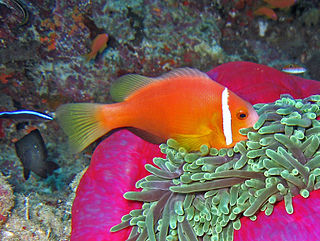
Amphiprion nigripes, is a marine fish belonging to the family Pomacentridae, which includes clownfishes and damselfishes.

The yellowtail damselfish is a species of damselfish native to tropical areas such as the Caribbean coast of Panama. Damselfish are abundant in coral reef environments. The International Union for Conservation of Nature lists this fish as being of “least concern”. The species is exploited on a minor scale, for fisheries and the aquarium trade. It may be threatened by the invasive lionfish.
Pomacentrus aurifrons, the yellowhead damselfish, is a species of ray-finned fish from the family Pomacentridae, the damselfishes and clownfishes. It is found in the western Pacific Ocean.
Chromis degruyi is a species of fish in the family Pomacentridae. It was first found at depths greater than 60 metres (200 ft) in a coral reef habitat in the western Pacific, specifically the Caroline Islands. It differs from its cogenerates on a colour and morphological basis.
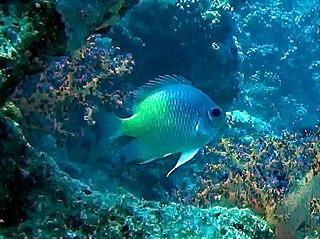
Amblyglyphidodon flavilatus, known as yellow damselfish, yellowfin damselfish, yellow flank damselfish, yellow side damselfish, and yellow-sided Damselfish, is part Pomacentridae, which is a family of ray-finned fish including damselfish and clownfish. This family represents the greatest diversity and abundance of fish species inhabiting coral reefs. They were first described in 1980 by Allen and Randall.
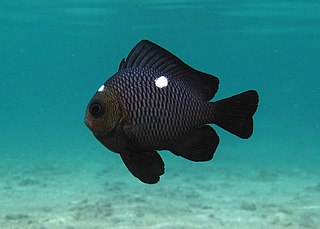
Chrominae is a subfamily of the family Pomacentridae, which consists of the damselfishes and the clownfishes.

Pomacentrinae is one of four subfamilies in the family Pomacentridae which includes the clownfishes and the damselfishes. It is the most diverse of the subfamilies in the Pomacentridae with around 21 genera and approximately 200 species.
Abudefduf conformis is a species of damselfish in the family Pomacentridae. It is native to the eastern central Pacific Ocean, where it is known from the Marquesas Islands. The species typically occurs in reef environments at a depth of 0 to 12 m.
